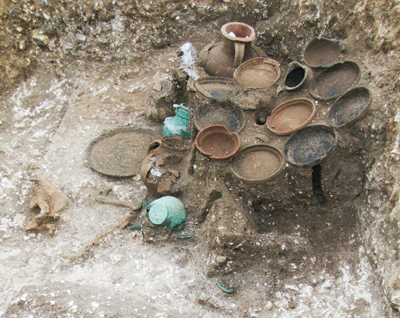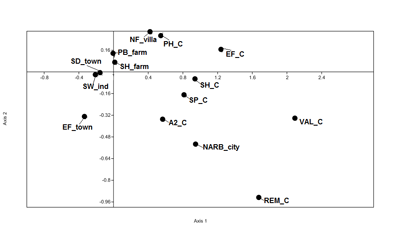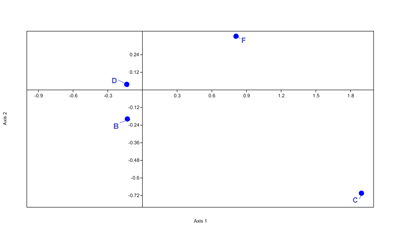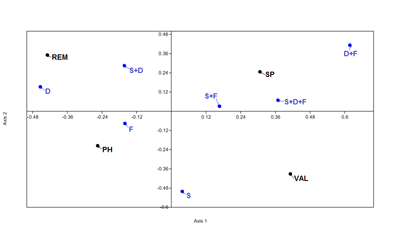
Cite this as: Biddulph, E. 2018 From Table to Grave: Examining Table Settings in Roman Britain from Funerary Evidence, Internet Archaeology 50. https://doi.org/10.11141/ia.50.7
It seems self-evident that mourners selecting pottery for graves in Roman Britain intended them to contain or represent food and drink for the deceased's journey to the afterlife or to allow the deceased to partake in funerary feasting. The vessels, typically beakers, flagons, cups, bowls and dishes, are, after all, tablewares, used in serving or consuming food and drink. It is not difficult to make the connection between dining and pottery deposition when we consider Grave 6260, a richly furnished 'high-status' grave uncovered during excavations on the A2 Pepper Hill-Cobham road scheme near Gravesend in north Kent. Twelve ceramic vessels had been laid out on a table, evident from remains and positioning of metal fittings and the fact that the vessels were raised above the floor of the grave (Figure 1). More vessels, both ceramic and metal, were placed at the foot of the table, including a wine-mixing bowl, platter, large flagon and a handled pan (Allen et al. 2012, 325-54). Graves in the nearby and contemporaneous cemetery at Pepper Hill in Southfleet were of lower status, but many nevertheless had provision for dining (Biddulph 2006a). While none contained evidence for tables as such, it is reasonable to assume that what was deposited in each grave represents an individual's share of a typical meal. This is potentially in contrast to the A2 burial assemblage, which, with its multiple vessels, may represent provision for multiple individuals. In any case, the implication is that grave groups offer an invaluable means of gaining information on otherwise rarely surviving table settings used in life.

As with any hypothesis, the idea that grave groups reflect how people dined in life must be tested. In this article, the hypothesis is tested by comparing funerary and non-funerary assemblages through statistical methods, chiefly correspondence analysis. The article also examines the dataset on the level of the individual grave to draw out patterns in the combinations of vessel types selected and assess the extent to which vessel selection conformed to notions of meals or dining.
Fortunately, we have a large body of pottery data that is amenable to a range of statistical and multivariate analyses. To the lower status Pepper Hill cemetery, we can add data from other cemeteries from Britain and other north-west provinces to form a comparative dataset (Table 1). For the purpose of the analysis presented here, the dataset is restricted to tablewares; that is, drinking-related forms – beakers (B), cups (C), and flagons (F) – and food-related vessels, specifically bowls, dishes and platters, all subsumed into a single class (D), from first and/or second-century CE cemeteries. Where possible, funerary assemblages have been compared with pottery data from associated settlements; thus, Pepper Hill is compared with the first and second-century pottery assemblages of Northfleet villa and Springhead roadside settlement, both near Gravesend in north Kent, while the mainly second-century cemetery from Elms Farm, Heybridge, is compared with an assemblage of pottery groups also of second-century date from its associated nucleated settlement. Other settlement sites that do not have associated cemetery data are also included in order to make the settlement dataset more representative in terms of chronology and site type. It is readily acknowledged that the dataset is by no means comprehensive, but the analysis and its results serve to signpost areas for further study.
| Site | Site type | CA code | Reference | Flagon | Beaker | Cup | Bowl/dish |
|---|---|---|---|---|---|---|---|
| Pepper Hill, Southfleet, Kent, UK | cemetery | PH_C | Biddulph 2006b | 112 | 118 | 7 | 105 |
| St Pancras, Chichester, West Sussex, UK | cemetery | SP_C | Down 1971 | 114 | 107 | 65 | 237 |
| Remagne, Libramont-Chevigny, Belgium | cemetery | REM_C | Fremault 1966 | 34 | 45 | 41 | 24 |
| Valladas, Saint-Paul- Trois-Châteaux, Drôme, France | cemetery | VAL_C | Bel 2002 | 109 | 19 | 79 | 65 |
| Strood Hall, Great Dunmow, Essex, UK | cemetery | SH_C | Biddulph 2007 | 14 | 13 | 5 | 14 |
| Elms Farm, Heybridge, Essex, UK | cemetery | EF_C | Biddulph et al. 2015 | 7 | 4 | 2 | 4 |
| A2 Pepper Hill-Cobham, Kent, UK | cemetery | A2_C | Biddulph 2012 | 3 | 4 | 5 | 24 |
| Stanford Wharf, Essex, UK | industrial | SW_ind | Biddulph et al. 2012 | 305 | 1638 | 56 | 5848 |
| Strood Hall, Great Dunmow, Essex, UK | rural | SH_farm | Biddulph 2007 | 381 | 702 | 62 | 2314 |
| Passingford Bridge, Stapleford Abbotts, Essex, UK | rural | PB_farm | Biddulph 2015 | 183 | 315 | 5 | 880 |
| Elms Farm, Heybridge, Essex, UK | nucleated settlement | EF_town | Biddulph et al. 2015 | 0 | 771 | 0 | 1080 |
| Close de la Lombarde, Narbonne, Aude, France | urban | NARB_city | Sanchez 2006 | 21 | 29 | 26 | 66 |
| Springhead, Gravesend, Kent, UK | roadside settlement | SD_town | Seager Smith et al. 2011 | 124 | 471 | 20 | 1566 |
| Northfleet, Gravesend, Kent, UK | villa | NF_villa | Biddulph 2011 | 515 | 285 | 89 | 1317 |
Where possible, non-funerary assemblages have been quantified by estimated vessel equivalents or EVE, which is the least biased method for quantifying vessel form, not being affected by differential fragmentation or vessel weights (Orton and Hughes 2013). In addition, given that the method records the surviving percentage of a rim, and is therefore a fraction of a whole, it is compatible with vessel count, the method used to quantify funerary assemblages. In Table 1, EVE data expressed as decimal numbers in the original publications have been multiplied by 100 to give a total percentage (thus, 24.13 EVE becomes 2413%). It should be noted, however, that two settlement assemblages have not been quantified by EVE. One is an assemblage from Clos de la Lombarde in Narbonne (Aude) in southern France in what was the residential quarter of the Augustinian city (Sanchez 2006). For this large assemblage of 2000 rims, quantification is presented by fabric only. A list of identified vessels given in that report has been used as the basis of a minimum number of vessels for the current analysis. It is not certain whether all identified vessels are represented in the published table, but for the purpose of comparison, the data must serve. The second assemblage is Springhead, the roadside settlement that Pepper Hill served. The data here have been quantified by vessel count based on all diagnostic elements – bases, body sherds, and, mostly, rims (Seager Smith et al. 2011, table 15).
Let us first turn to a comparison of assemblages by site. Correspondence analysis (CA) is a useful means of establishing patterns and testing the relative importance and strength of associations between variables, in this case vessel class and site assemblage. The scattergram, the end-product of analysis, provides a visual means of comparison. Variables that are similar in terms of their assemblage composition will broadly occupy the same space on the plot, while the point at which the axes intersect represents the average across the combined dataset.
Before examining the plot, it is worth noting that most of the patterning is shown by the two axes; axes 1 and 2 account for 89.7 per cent of the total inertia, with axis 1 alone accounting for 74.1 per cent. Just 10.3 per cent of the pattern is invisible on the plot. With any multi-dimensional representation of the data, there will inevitably be distortion when the data are shown on a two-dimensional plot. In this case, just three dimensions are required to accurately show the distribution of the data points or inertia, the weighted distance of each data point from the average (Shennan 1997, 318-21).
Looking first at sites only, when plotted on the scattergram the dataset generally shows a division between funerary assemblages (here suffixed with a C for cemetery) on the one hand and settlement assemblages on the other (Figure 2). The cemetery assemblages sit on the right-hand side of the plot, with Elms Farm, Heybridge (Essex), Strood Hall, Great Dunmow (Essex), St Pancras, Chichester (West Sussex) and A2 Pepper Hill-Cobham (Kent) assemblage forming a loose linear grouping. The two assemblages from Continental Europe, Remagne (Libramont-Chevigny, Belgium) and Valladas (Drôme, France), lie further to the right. The settlement assemblages form another loose group across the axial intersection, although within that group, Passingford Bridge (Essex) and Strood Hall (Essex) are paired, as are Springhead (Kent) and Stanford Wharf Nature Reserve (Essex). The settlement of Elms Farm, Heybridge, is a little isolated in the bottom left quadrant. Two other observations are of interest. Pepper Hill cemetery (Kent) appears to be paired with Northfleet villa (both in north Kent and c. 2km apart), while the urban assemblage of Narbonne (Aude, France) lies among the cemetery assemblages. The plot shows in general that funerary assemblages and most domestic assemblages are separated by their ceramic profiles; their assemblages do not match. However, the proximity of urban settlement and funerary assemblages indicates that the two are more closely aligned, with the funerary assemblages sharing elements of the non-funerary urban ceramic profile. Similarly, the profile of Pepper Hill and that of the higher status settlement site, Northfleet villa (rather than, it should be stressed, Springhead, the settlement that Pepper Hill served), are also well matched.

When we switch to vessel class, we see that food-related forms (dishes, bowls and platters) and beakers are plotted close to the axial intersection, roughly coincident with the settlement assemblages, while cups are firmly within the quadrant occupied by cemetery assemblages and the urban assemblage of Narbonne (Figure 3). Flagons are plotted towards the top of the plot closer to Northfleet and Pepper Hill. The plots suggest that cups are strongly associated with urban and cemetery assemblages, while the position of flagons is strongly influenced by Pepper Hill and its neighbouring villa site. Beakers and food-related vessels, being close to the axial intersection, represent the average across the whole dataset. They are a component of most assemblages, but help in particular to pull the A2 Pepper Hill-Cobham, St Pancras, Pepper Hill, and Strood Hall cemetery assemblages towards the centre. The pairing of Passingford Bridge and Strood Hall settlements is likely to reflect the fact that both share geographical, functional and chronological attributes. The pairing of the roadside settlement and sanctuary site of Springhead and the salt-production site of Stanford Wharf Nature Reserve hints at an association based on their specialist characters, but also their geographical proximity, being situated on opposite sides of the Thames.

What can we make of these observations? One obvious conclusion to draw is that funerary assemblages associated with lower status sites are fundamentally different from the sites' domestic assemblages. While there are some aspects in common, notably beakers and bowls/dishes, the over-representation of flagons, and to a lesser extent cups, in funerary assemblages reminds us that these classes do not have a significant presence in lower status non-funerary assemblages. Thus, the pottery from the cemetery at Elms Farm, Heybridge, has a markedly different profile to that of contemporaneous groups from the Elms Farm settlement. Flagons (or, rather, flasks) account for 17 per cent of the funerary assemblage by vessel count, but are absent in the settlement assemblage. Likewise, the assemblages from the Strood Hall farmstead and its accompanying cemetery are also clearly differentiated, beakers, for instance, taking a 25 per cent share of the grave goods, but just a 7 per cent share of the settlement pottery by EVE.
Another point to make is that the higher the status of settlement, the closer its ceramic profile is to funerary assemblages. We see this in the positioning of the assemblage of Northfleet villa and that of Valladas. In other words, funerary assemblages, even those attached to low-status rural sites, appear to have an essentially urban character about them. This does not, however, necessarily indicate that inhabitants were reproducing Roman foodways in a funerary setting, but rather expressing what John Pearce (2015) calls an urbane sociability or Roman-style usage through the selection of ceramics, which take on symbolic meaning.
A comparison of assemblages provides insight on a site level, but the patterns can mask important variations within site assemblages. For example, while the Pepper Hill funerary assemblage on the whole has roughly equal proportions of drinking-related and food-related vessels (Table 1), suggesting a generally balanced provision of table forms, a look through the grave catalogue shows that on the level of the individual grave, there is much greater variation, with full, partial or no representation of table settings (Biddulph 2006c). In order to examine variation across graves, we can define the numerous functional combinations observed within the major cemeteries – graves with drinking vessels only, graves with food-related vessels only, graves with food, drinking and liquid-serving vessels (what might be termed a complete table setting), and so on. We can then quantify the results (Table 2).
| Site | Ca code | Functional combination | Total graves | ||||||
|---|---|---|---|---|---|---|---|---|---|
| S only | S+D+F | S+D | D+F | F only | D only | S+F | |||
| Pepper Hill, Southfleet, Kent, UK | PH | 46 | 21 | 14 | 2 | 26 | 49 | 19 | 177 |
| Valladas, Saint-Paul-Trois-Châteaux, Drôme, France | VAL | 26 | 18 | 5 | 6 | 3 | 4 | 5 | 67 |
| St Pancras, Chichester, West Sussex, UK | SP | 17 | 41 | 16 | 21 | 16 | 25 | 22 | 158 |
| Remagne, Libramont-Chevigny, Belgium | REM | 7 | 9 | 14 | 4 | 5 | 30 | 3 | 72 |
At Pepper Hill, 49 (28 per cent) graves with ceramic grave goods have drinking vessels only. A further 46 (26 per cent) graves contained liquid-serving vessels only. A full table setting – a food vessel, drinking vessel and liquid-serving vessel – was present in just 21 (12 per cent) graves. This can be contrasted with Valladas, where a full table setting was recorded in 18 (27 per cent) of pottery-yielding graves. Graves with liquid-serving vessels (26 in total) only take a 39 per cent share, while just 6 per cent of graves (4 in total) contained drinking vessels only. The best-represented category at Remagne was drinking vessels only (30 graves or 42 per cent), with liquid-serving and drinking vessels a somewhat distant second (14 graves or 19 per cent). Graves with full table settings were well represented at St Pancras (41 graves or 26 per cent), followed by graves with drinking vessels only (25 graves or 16 per cent).

We can gain further insight when we subject the data to correspondence analysis. The resulting scattergram of selected cemetery assemblages displays sites and combinations (Figure 4) only along axes 1 and 2, which together account for 88.2 per cent of the total inertia. The urban assemblages, namely St Pancras (Chichester) and Valladas, lie on the right-hand side of the chart in association with grave groups of multiple function. The full table setting is particularly strongly associated with St Pancras. The left side of the plot contains the larger settlement cemeteries of Pepper Hill and Remagne. These sites are more closely associated with single-function grave groups, that is, graves containing drinking or food vessels only.
Given its size and range of funerary-related features, encompassing pyre-sites, pyre-related features, cenotaphs, and bustum-type graves (where the cremated remains of the body drop into a grave-shaped pit below the pyre), as well as inhumation and cremation graves, Pepper Hill allows us to examine whether there were different criteria for the selection of pottery based on funerary rite. For example, ten complete or near-complete vessels were recovered during excavation from pyre-sites, having been placed on the pyre and cremated with the body, and several more vessels are known from fragments (Table 3). Previous analysis by the author that compared the composition of pyre- and grave-good assemblages at that site revealed that the pyre-good assemblage had a strong emphasis on drinking, with flagons and beakers well represented (Biddulph 2006b, 23-6). Food-related vessels – bowls and dishes – were absent, though jars were also well represented among the pyre-goods identified from fragments. In contrast, the unburnt grave-good assemblage had a more balanced composition, approaching what might be termed a full table setting. Drinking-related vessels were predominant, but food-related vessels made an important contribution. That said, there were some differences: bowls and jars were better represented in the grave-good assemblage from cremation graves than in the grave-good assemblage from contemporaneous inhumation graves.
| Beaker | Bowl | Dish | Cup | Flagon | Jar | |
|---|---|---|---|---|---|---|
| Pyre goods | 2 | - | - | - | 8 | 1 |
| Other pottery from pyre sites | 146 | - | - | 325 | 383 | |
| Cinerary urns | 1 | 9 | 2 | 1 | 63 | |
| Accessory vessels, cremation graves | 52 | 16 | 38 | 8 | 55 | 25 |
| Accessory vessels, inhumation graves | 46 | 5 | 44 | - | 54 | 11 |
This is not the place to examine these differences in detail (see Biddulph 2006b for further discussion), but it is worth noting that the classes of vessels better represented in the cremation graves than in inhumation graves – jars and robust bowls – are typically the classes used as cinerary urns. Potentially, then, the reason for the difference might be found in the beliefs relating to burial rite. Similarly, the differences between the pyre-good and grave-good assemblages point to vessel selection determined by funerary rite, with a specific suite of vessels associated with each stage or rite. Another interesting aspect concerns the choice of individual drinking vessel, that is the paucity of cups (in a British context usually available in imported finewares, such as samian forms Drag. 27 or 33 or Gallo-Belgic form Cam 56) and dominance of beakers. The reason may reflect cultural preferences and the availability of alcoholic beverages in life, with beakers perhaps being associated with the consumption of ale among the wider population, and cups associated with wine-drinking, which may have been socially restricted, for example to the elite (Biddulph 2005).
To return to the central question of this analysis – to what extent did grave groups represent table settings used in life – the answer appears to be to a varying extent. Grave groups, typically comprising some combination of dishes and bowls, beakers, cups and flagons, clearly have a relationship with Roman table settings, whether in full or part. As a rule, funerary assemblages, whether belonging to lower or higher status settlements, are closest to high-status settlements in terms of ceramic profile. The types of forms routinely placed in graves were commonly seen in the assemblages of higher status settlements in urban centres and less frequently in lower status settlements. Mourners selecting and depositing pottery in graves at, say, St Pancras (Chichester) may well have seen the same sort of pottery on their dining tables on a regular basis. Similarly, the individuals buried in the high-status graves on the A2 in Kent may also have used the same types of pottery in life. In contrast, pottery deposited in graves at, say, Strood Hall, did not form part of their associated settlements' normal, everyday traditions of pottery use and dining. Or to put it another way, for many inhabitants of lower status settlements, the only time they saw flagons or cups was when someone died. Those forms were deliberately acquired, perhaps away from the settlement or through a different source to the usual means of pottery supply, in order to be deposited in the grave in apparent imitation, in a largely symbolic way, of elite or urban usage.
Most grave groups preserved some aspect of Roman table settings in their composition, but the full setting itself – that is, a food vessel, a drinking vessel and a liquid-server together – was not always provided in individual graves in south-east Roman Britain. However, there is some evidence to suggest that the frequency of the full setting or at least a food vessel and a drinking vessel being provided together increased with settlement status. Thus, graves with a combination of a food vessel and drinking-related vessel are well represented at St Pancras, while at Pepper Hill, the emphasis is on individual functions, whether eating only or drinking only.
It is important to recognise, too, that different funerary rites may have required different suites of vessels. At Pepper Hill, rites relating to the cremation itself tended to require drinking-related vessels, while both food-related and drinking vessels were acceptable at the burial stage.
Internet Archaeology is an open access journal based in the Department of Archaeology, University of York. Except where otherwise noted, content from this work may be used under the terms of the Creative Commons Attribution 3.0 (CC BY) Unported licence, which permits unrestricted use, distribution, and reproduction in any medium, provided that attribution to the author(s), the title of the work, the Internet Archaeology journal and the relevant URL/DOI are given.
Terms and Conditions | Legal Statements | Privacy Policy | Cookies Policy | Citing Internet Archaeology
Internet Archaeology content is preserved for the long term with the Archaeology Data Service. Help sustain and support open access publication by donating to our Open Access Archaeology Fund.